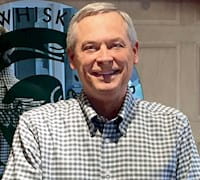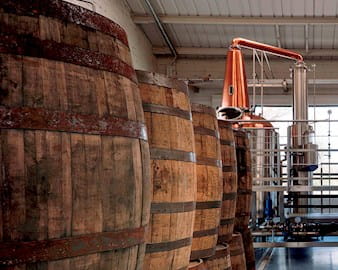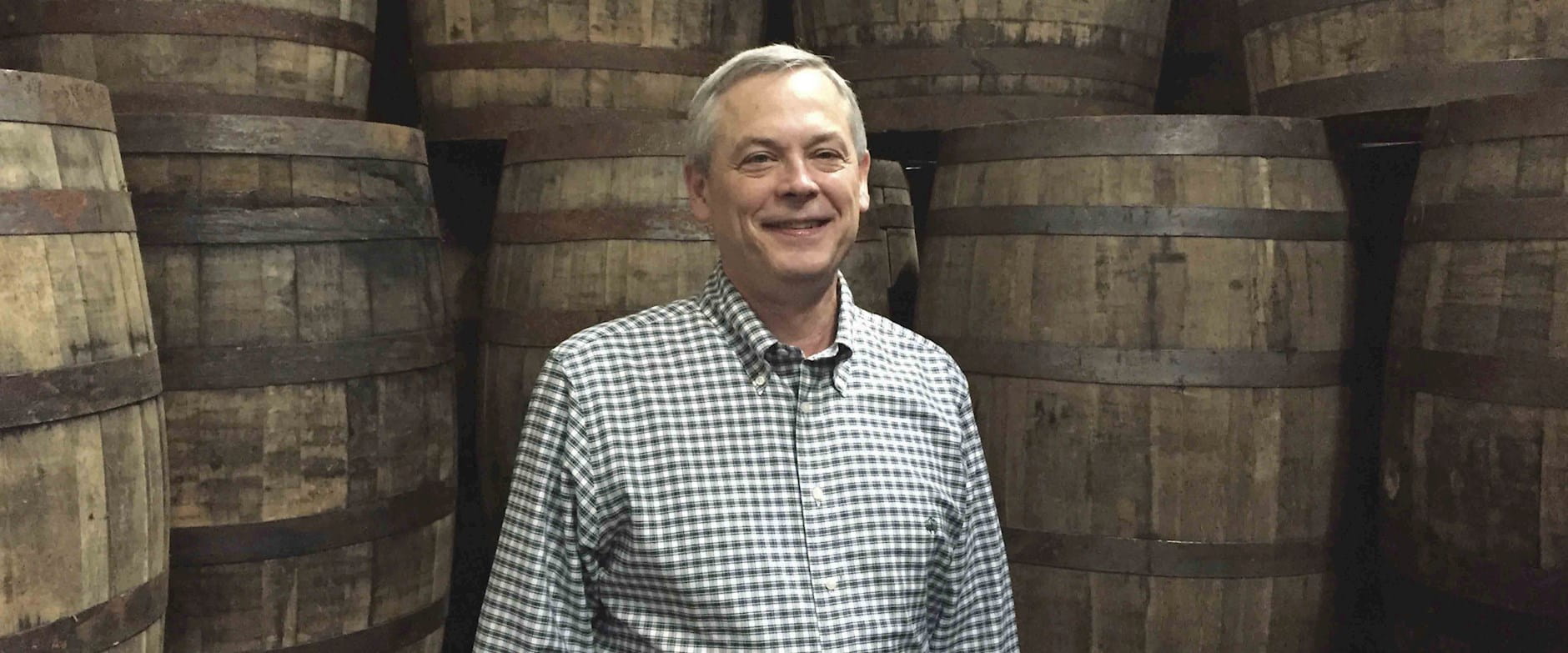Many people dream of one day owning a bar. Instead of slinging drinks to individual patrons, though, self-made entrepreneur Tom Jensen, ’87, opted to serve bar owners and liquor distributors instead. Thankfully, the spirits industry was quick to raise a glass and invite him over.
After three decades working his way through various distilleries and up distributors’ ranks, Jensen founded two startup distilleries of his own: New Liberty Distillery making bourbon in Philadelphia, and the Connacht Distillery making high-end single-malt Irish whiskey in County Mayo, Ireland. Today, these ventures are going strong, thanks in part to the work ethic Jensen’s parents instilled in him early on.
“Everyone thinks that the alcohol and bar space is all fun and glory, but it’s a business,” Jensen says. “What I’ve learned over the years is that it’s important to put in the hours, push yourself, and focus on building a strong team that brings people with different backgrounds and insights to the table. I’ve also learned how important it is to focus on product quality, which started me on a journey of over 40 years in the spirits business.”
After graduating from college in 1982, Jensen went straight from managing a student-run watering hole to pitching alcohol door-to-door as a salesperson for E. & J. Gallo Winery. It was during this time that he enrolled in Booth’s Evening MBA Program, following the advice of his Gallo boss, who was a Booth grad. Studying marketing and behavioral science, Jensen was fascinated by the discussions he had with other professionals. “It was a special privilege to be able to bring real-life business questions into the classroom,” he notes. Equally important, his time at Booth taught him to keep a close eye on fast-changing markets, stay attuned to shifting customer trends, and ask lots of questions. These skills would come in handy for years to come as he navigated the rapidly shifting world of alcohol and spirits.

“Everyone thinks that the alcohol and bar space is all fun and glory, but it’s a business."
— Tom Jensen, ’87
Jensen then moved on to Hiram Walker–Gooderham & Worts, a Canadian-based distiller behind iconic brands such as Canadian Club, Courvoisier, and Kahlua, before continuing with United Kingdom–based Allied Domecq, which acquired the firm years later. He held myriad regional and national sales management positions over the years, watching industry trends ebb and flow. “Back in the 1980s and ’90s, the industry was all about flavored vodka and Red Bull, then the cocktail renaissance came, and so on,” he says. “Back then, you couldn’t give whiskey away if you tried.”
But by the time he landed at beverage giant Rémy Cointreau USA in 2004—first as executive vice president of sales, then CEO—he could see the winds of fortune swinging back the spirit’s way again.
“I saw the alcohol industry start to shift toward trends like farm-to-table and craft brewing, and a greater appreciation for local products,” Jensen explains. “Now we’re at a place where people are fascinated by and are willing to pay more to try a spirit that’s made in their zip code.” But back then, these movements were still in their infancy, and he couldn’t convince Rémy to acquire a bourbon brand or Irish whiskey label.
Managing the company’s more than $400 million business taught him that finding success in the market isn’t always about being the biggest company in the field. Rather, he says, it’s more important to focus on making your products stand out. Jensen also learned that consumers expect different things from spirits targeted at different price points, leaving ample room for industry differentiation. A high-quality product at any price is always in demand.

When he left Rémy in 2010, he was convinced that whiskey and bourbon were poised to make a market impact. Having gained the confidence to create his own brand and vision, Jensen (of Irish descent himself) realized that Irish whiskey enjoyed little presence in America, but suspected that would soon change. Pairing the entrepreneurial skills he gained at Booth with his decades of experience (plus startup funds partially raised from his former Gallo boss), Jensen set out to remake the way Americans toast.
Today, his New Liberty Distillery produces sumptuous spirits in small batches using ingredients sourced from local farmers. “We focus on making beautiful whiskeys,” he says, “what we call grain-to-glass.” Having also resurrected the classic Pennsylvania whiskey brand Kinsey, his distillery is keeping the iconic label going strong to this day.
After spending considerable time hunting for a master distiller (“if you don’t have the right person, you won’t produce good products”), he also opened the Connacht Whiskey Distillery in Ireland. His goal: export American craft ideas to the Irish market, and import Irish whiskey sensibilities and traditions to American consumers.
As for why he opened two distilleries making distinct products on two continents, Jensen says the answers are more practical than you think. “By law, Irish whiskey must be three years old in order to sell it as Irish whiskey—and to be honest, it needs to be four or five years old until it tastes great enough to be sold,” he confesses. “It’s a slow play that entails a lot of investment. American bourbon, on the other hand, you can innovate and do many things to make it taste better. You can also legally sell it after day one as bourbon and create a great tasting product in as soon as six months.”
Now coming up on 10 years in business, Jensen looks forward to cheering even more success in the decades to come. He says you don’t have to be a connoisseur to appreciate all that these distilleries have to offer. “One thing people should know about whiskey is not to be intimidated by it. Every variety offers its own sense of charm and style, from rye to scotch and bourbon,” he counsels. “I recommend trying as many whiskeys as you can—each has different flavors and attributes that are unique and special and really worth exploring.”
Anatomy of a Stiff Drink
Jensen breaks down essential whiskey terms that every aspiring connoisseur should know.
Peaty: “A style of whiskey that has a smoky character to the nose and taste of the drink.”
Single malt: “All malt whiskey is made from malted barley. Single malt basically means that it was made in a single distillery—it’s milled, fermented, distilled, and barreled at one site.”
Terroir: “It’s all about the influence of the environment on the beverage. In Ireland, we’re right by an estuary where the Atlantic Ocean comes in and meets the fresh water and you get a little salt in the air. It permeates into where we store our barrels and influences the barrels and aging of the whiskey.”
Cask strength: “When a whiskey is barreled, it’s at a much higher proof than when you bottle it for consumption. That’s cask strength. Sometimes we release whiskeys at this strength so customers can add a little water and dilute to taste. At the higher proof, you get more flavor and really get to taste the spirit.”
Cooperage: “It describes the characteristics of the barrels and quality of the wood that your whiskey is aged in, which affects the flavor of the whiskey you produce.”
Single estate: “As with wine, it means that the spirit is from one producer. It’s a term of quality that means you’re not getting a blend of beverages from multiple areas, plantings, or producers.”


